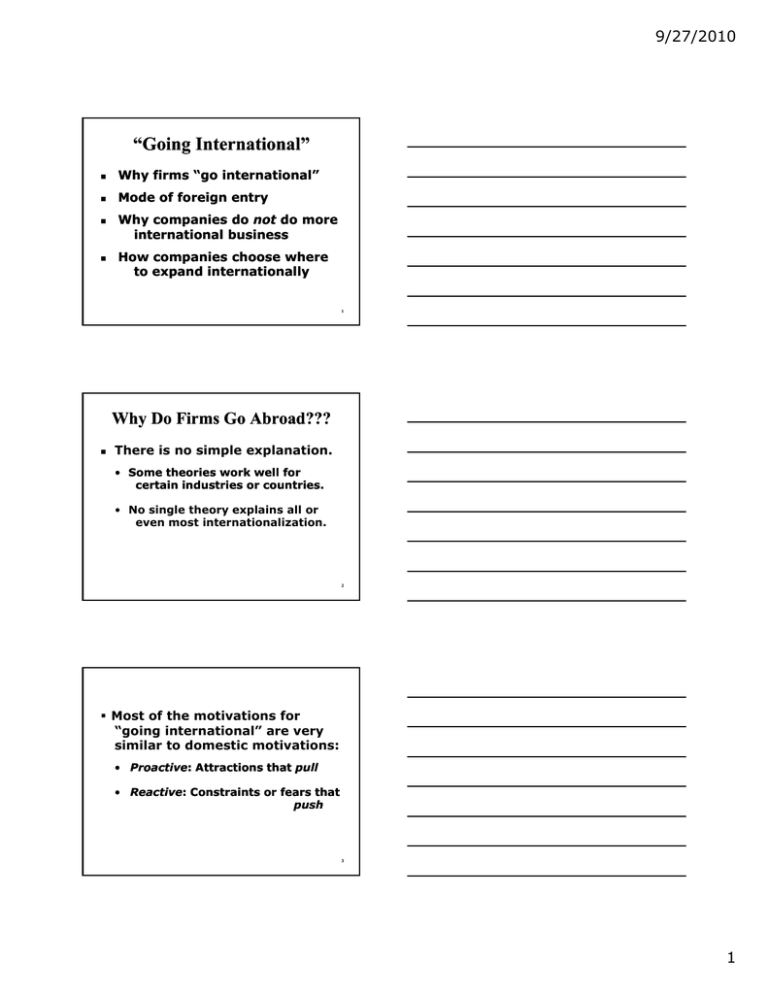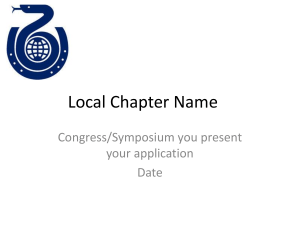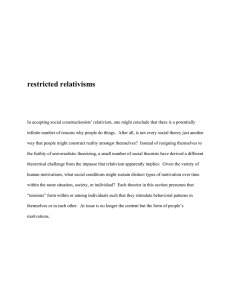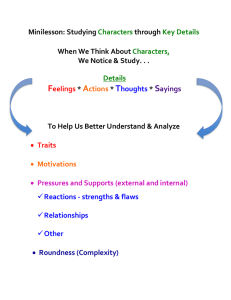“Going International” 9/27/2010
advertisement

9/27/2010 “Going International” Why firms “go international” Mode of foreign entry Why companies do not do more international business How companies choose where to expand internationally 1 Why Do Firms Go Abroad??? There is no simple explanation. • Some theories work well for certain industries or countries. • No single theory explains all or even most internationalization. 2 Most of the motivations for “going international” are very similar to domestic motivations: • Proactive Proactive: oact e: Attractions tt act o s tthat at pu pull • Reactive Reactive:: Constraints or fears that push 3 1 9/27/2010 Pull Motivations 4 Proactive--Seeking Proactive-Seeking Opportunity: Conditions that Pull Us Abroad Most motivations for “going international” are proactive: • Seeking productive efficiency • Seeking markets 5 Productive-Efficiency ProductiveMotivations Acquiring productive assets that will improve efficiency: factors of production Quality Quantity Cost 6 2 9/27/2010 Factors of Production Natural resources • Raw materials (e.g., water, minerals, arable land) • Biological resources (e.g., forests, fish) • Climate (e.g., temperature, weather, rainfall, topography) 7 Factors of Production (2) Labor • Inexpensive • Highly skilled Technology 8 Other Productive Motivations Good infrastructure Diversification of supplies Diversification of production Vertical integration 9 3 9/27/2010 Internalization Taking advantage of existing internal factors of production • Management • Technology • Other critical factors of production 10 Financial Incentives Access to lowerlower-cost funds Financial incentives of governments • Grants and cheap loans • Inexpensive sale or rent of assets • Tax holidays • Investment in infrainfra-structure 11 Marketing Motivations (1) • To develop or expand the company’s role in foreign markets • To simply protect its existing position in those markets (defensive marketing) 12 4 9/27/2010 Marketing Motivations (2) To escape limited market opportunities at home To utilize excess capacity p y( (e.g., g, equipment, management, labor) To get behind trade barriers abroad 13 Marketing Motivations (3) Location -- to be close to customers: • To reach customers who cannot be reached h d ffrom afar f • To reduce transportation costs • To provide just just--in in--time scheduling 14 Marketing Motivations (4) Quickly respond to changing market conditions • Overall demand • Style preferences “Follow the customer” customer” 15 5 9/27/2010 Marketing Motivations (5) To diversify the customer base • Vertical integration • Horizontal integration 16 Marketing Motivations (6) To extend the product life cycle “Follow the leader” leader” To c create eate o or enhance an “international” image To preempt strong competitors 17 All of the above motivations have been proactive— proactive—business responding to the pull of foreign production or marketing opportunities. 18 6 9/27/2010 Push Motivations 19 Reactive -- “Push Push” ” Motivations for “Going International” “Push” motives are defensive. Many are similar to domestic motivations. However, some are strictly international. 20 Economic “Push” Factors Bad economic conditions at home • Protracted recession • High inflation High labor costs or labor unrest 21 7 9/27/2010 Economic “Push” Factors Intense competition at home Saturated home market High taxes 22 Political “Push” Factors Government limitation on the company’s domestic expansion Restrictive government controls and bureaucratic obstacles Fear of expropriation Fear of civil unrest or war 23 Going International 24 8 9/27/2010 Going International: Mode of Foreign Entry Passive: No active involvement in Passive: management Active: Active involvement in Active: management of international operations 25 Passive International Business Foreign portfolio investment Leasing intellectual property • Licensing • Franchising 26 Active International Business Exporting & importing • Goods / merchandise • Services Foreign direct investment (FDI) 27 9 9/27/2010 Foreign Direct Investment Investment in which the company exercises managerial control • Total control • Shared control 28 FDI: Total Control Unilateral venture • Merger g or acquisition q • "Greenfield Greenfield" " 29 FDI: Shared Control Cooperative venture with other companies (or government agencies) • Joint venture • Other forms of strategic alliance Consortium 30 10 9/27/2010 Barriers to International Business: Government Management 31 Why Companies Do Not Do More International Business Government barriers • Explicit • Implicit Managerial barriers 32 Explicit Government Barriers Formal government obstacles • Trade controls • Exchange controls • Money & capital controls 33 11 9/27/2010 Trade Controls Tariffs / duties Quotas Licenses Queues 34 Exchange Controls Government control of exchange rates • Unrealistic U li ti valuation l ti • Inconvertibility • Multiple exchange rates 35 Money & Capital Controls Government control of money & capital markets • Taxes • Quotas [e.g., transfer risk] risk] • Queues • Advanced deposits 36 12 9/27/2010 Implicit Government Barriers Deliberate, but informal, obstacles imposed by government • Red tape • Administrative opposition • Erratic behavior 37 Political Obstacles War and other international tensions Domestic unrest [political, [political labor, labor religious, regional, linguistic] Expropriation 38 Proactive: Government Efforts to Attract FDI Assistance (by the host country) • • • • Subsidies and loans T Tax incentives i ti Infrastructure improvement Facilities Insurance (by the home country) 39 13 9/27/2010 Investment Insurance (1) Insurance on investments in developing countries • War, insurrection, civil unrest • Inconvertibility • Expropriation • Commercial risk 40 Investment Insurance (2) Source of investment insurance • Individual government U.S.: Overseas Private Investment Corporation (OPIC OPIC) ) • World Bank: Multilateral Investment Guarantee Agency (MIGA MIGA) ) • Private insurance companies 41 Managerial Barriers Limited ambition Limited knowledge Claims of inadequate resources Fear Managerial Inertia 42 14 9/27/2010 Choosing Where to Expand Internationally In theory, “going international” should be a thoroughly objective, rational process-process-• Searching for as many feasible alternative opportunities as possible. 43 Choosing Where to Expand Internationally However, additional motivations and constraints are inevitably involved. • Resource limitations Management time Money • Corporate policy (e.g., within a four--hour travel time) four 44 Managerial Biases or Comfort Ethnic bias • English English--speaking only • Muslim countries only Geographic bias (e.g., only within NAFTA or the European Union) 45 15 9/27/2010 Attracting FDI Why are some countries so much more successful than others in attracting foreign direct investment? 46 16





